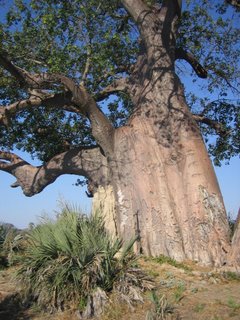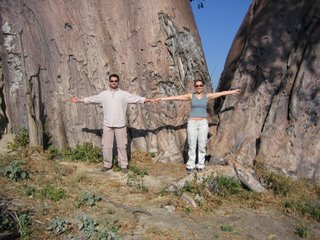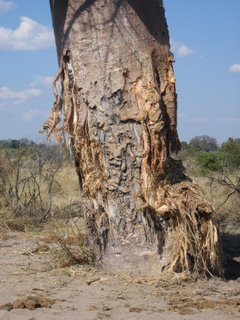I just love myself a fat Baobab tree! The first time I saw these giants was when Ricardo and I drove from Chimoio to the little town of Espungabera where the tea project we raised $600,000 for will eventually be located. Both Chimoio and Espungabera are in Mozambique, but the roads in that part of the country are so bad that it was easier to cross the border to Zimbabwe and drive some 150km out of our way just so that we could be on tar roads and drive over 70 km/hr. It was driving through the Eastern Highlands of Zimbabwe that I first saw a Baobab. I was amazed at how large they were, big fat stumpy things jutting out of the dusty landscape, but somehow beautiful and majestic at the same time. Unfortunately, I never got a photo of a Baobab on the multiple trips to Zimbabwe we took last year.
I was grateful to have my camera charged and ready when we came across a few Baobabs in Botswana. This gigantic tree was at Seba Camp, and what I managed to capture in the photo is actually only one half of the entire tree.

To put things in perspective, here is the entire trunk of the Baobab with my family, Ricardo, our guide Max and I lined up in front of the tree for a portrait. This thing would put the redwoods in California to shame! Max told us that this particular Baobab is more than 2,000 years old.
Ricardo and I decided to stretch our arms as far out as we possibly could in this photo. Even so, we were totally dwarfed by the thickness of the Baobab.

In another part of Seba Camp, we came across a slightly smaller Baobab whose trunk looked as if it had been attacked by an industrial shredder. Max informed us that the damage was caused by elephants, who have a habit of stripping the bark off trees in the bush to feed themselves. This causes a huge problem, because most trees can't regenerate their bark and once an elephant strips off the protective outer layer, the tree can't hold in moisture and eventually dies. Most of the dead trees you see in the bush are the result of elephants.
Baobabs, however, are a different story. They are one of the elephants' favorite trees because their bark and inner fibres are very fleshy, almost sponge-like. But no matter how much damage an elephant may cause, the Baobab is able to regenerate and form "scars" to heal the places where its bark and fibres have been stripped away. It's an amazing evolutionary trait, and the end result is these very cool, lumpy areas on the outside of the Baobabs. This tree has already regenerated a good part of the damage from the elephants, but even so it is in danger of toppling over should another feeding attack occur.
Here is a close-up of Rico inspecting the damage the elephants caused. You can see part of the trunk that has been regenerated from previous elephant feeding, just to the right of the torn up fibres.
This particular Baobab our guide estimated to be about 1,000 years old.




6 comments:
They are absolutely beautiful... and they remind me of our "insignificance". O homem é o único animal que cospe na água que bebe, já dizia o Velho do Rio do Benedito Ruy Barbosa :)
What beautiful amazing trees! I like how they are so big that you guys look tiny in front of them!
I had to call GB in from another room to come look at these pictures, they were totally mind-blowing. Everything you've shown us of your time in Botswana has been utterly incredible and I'm so appreciative of your beautiful pictures and words -- I really feel like I see it through your eyes.
i have a feeling that every time i come to your blog i am going to post the same comment, namely - WOW! these tress are amazing - i had heard of them, but never seen a photo like this. they are like cliff faces, what incredible power they must hold. fabulous - thanks for blowing my mind a bit on a sunday afternoon :-)
Wow! Amazing. I am going to email you some Africa questions soon. :-)
These trees dwarf the significance of the human race. They outlast us and are beautiful. And I'm sure much kinder than we.
xo
Post a Comment